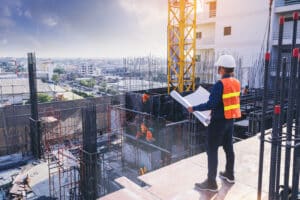If you're exploring energy tax incentives for your next development, you're already ahead of the game. Surprisingly, many developers overlook significant tax breaks like the 179D deduction—or they miss their chance to claim maximum benefits by not acting early enough.
You may think of energy tax incentives such as 179D as a potential bonus to discover after your project is complete. But that misconception could be costing you serious money! The truth is, the 179D Energy Efficiency Tax Deduction has evolved, and the biggest rewards now go to those who get involved from the very start of their project.

This guide will answer the question of when to consider energy tax incentives, lay out a timeline for every project stage and provide useful tips on maximizing your benefits. Read on to discover how to claim tax savings for your next energy-efficient construction project.
Projects That Are Perfect for 179D
Before diving into the nitty-gritty details, let's lay out some basics. As a reminder, 179D is a federal tax deduction designed to reward developers who create buildings that exceed energy performance standards. This tax deduction is especially advantageous in two key scenarios:
First, there's new construction. When you're building from the ground up, you have a golden opportunity to include energy-efficient features in the core design. Working with architects and engineers who are aware of 179D requirements allows you to optimize systems for maximum deductions.
Second, major renovations offer valuable savings potential. Targeting substantial upgrades to your building's HVAC system, lighting fixtures, and building envelope (walls, roof, insulation, windows, etc.) potentially results in significant deductions.
Why Thinking About 179D Early Is Now Essential
In the past, considering 179D benefits after a building was completed was relatively common. However, recent changes to the tax code have shifted the playing field so that early planning is now crucial to maximize your deductions.
Optional Labor Standards
The 179D deduction now offers the potential for a substantial increase if your project meets certain labor requirements, including paying prevailing wages and utilizing a qualified apprenticeship program. To take advantage of this enhanced deduction, you'll need to consider:
- Hiring strategically: It takes time to source contractors and laborers that adhere to the prevailing wage regulations in your area.
- Budgeting accordingly: Potential increased costs associated with the new labor standards need to be factored into your project budget early on.
- Finding apprentices: You’ll need time to research and partner with qualifying apprenticeship programs.
Pre-Construction Planning
But what if you just want to take the base-rate deduction? Even if you don’t plan on worrying with the optional labor standards, you’ll still need to be mindful of 179D requirements during the initial design phase of your project. It’s much easier to achieve the necessary energy reductions when you design with energy efficiency as a central goal from the start, rather than trying to retrofit your design to meet energy standards after the fact.
Your 179D Timeline for Success
To get the most out of the 179D deduction, a well-timed strategy is essential. The earliest stages of your project are an ideal time to introduce the concept of 179D to your architects, engineers and financial decision makers.
Step 1: Design
Now is the time to partner with tax experts who specialize in 179D. Their in-depth knowledge will help you:
- Identify energy-efficient systems that qualify for the deduction.
- Make adjustments to your design to maximize energy savings.
- Evaluate the pros and cons of pursuing the optional labor standards for the increased deduction.
Step 2: Construction
If you've chosen to pursue the enhanced 179D deduction, your hiring practices during the construction phase must align with prevailing wage regulations and apprenticeship requirements. You’ll also need to be meticulous about maintaining labor records, including work hours.
Even if you aren’t incorporating labor standards, you should still keep records documenting your process. Knowing the specifics on the systems you installed, energy performance data and any changes made to the original design will make filing your claim much easier (and help protect you in case of IRS audit).
Step 3: Post-Completion
Once construction is finished, the final steps involve working with a “qualified individual” (typically a licensed engineer or architect) to conduct a thorough energy study of your building. This evaluation confirms that your improvements meet the required energy standards and that your documentation is thorough. The qualified individual will generate any necessary energy modeling reports as well as the official certification.
You’ll then be ready to claim the 179D deduction on your tax return. This can be done either for the tax year in which the building was placed in service or through an amended return later down the line.
Don't Miss Out—Partner with Experts
The world of tax regulations, especially surrounding niche deductions like 179D, is complex and constantly evolving. The best way to ensure you're navigating these intricacies correctly and maximizing your deduction is by collaborating with experienced tax specialists.
Engineered Tax Services (ETS) is a licensed specialty tax and engineering firm that’s been helping clients save on taxes for over 20 years. Our team has extensive experience with all things 179D, making us uniquely qualified to walk you through the complicated process.
Don't leave potential tax savings on the table! Seek expert guidance on the 179D deduction and integrating energy efficiency into the heart of your development projects. Together, we can benefit both the environment and your bottom line.



